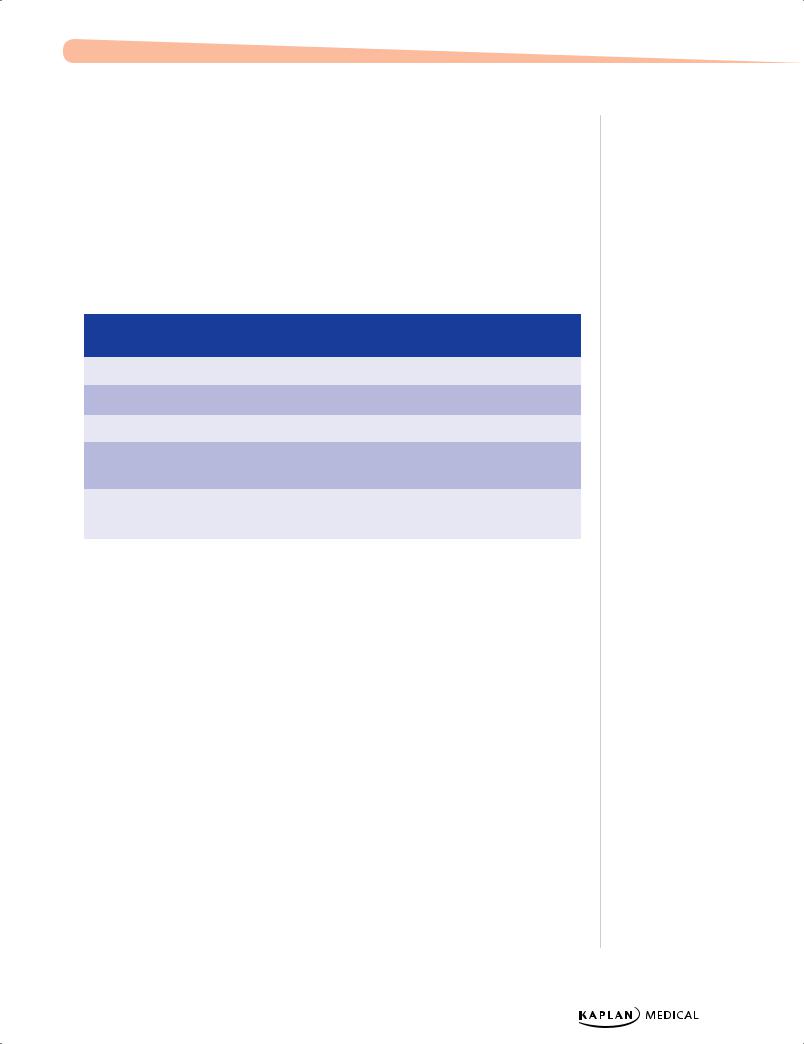
Полезные материалы за все 6 курсов / Учебники, методички, pdf / Kaplan Pediatrics USMLE 2CK 2021
.pdf
USMLE Step 2 CK λ Pediatrics
•Clinical phases
–Acute febrile: 1–2 weeks (or longer without treatment), diagnostic and associated findings and lab abnormalities; WBC increased (granulocytes), normocytic /normochromic anemia, normal platelets in first 1–2 weeks; ESR and CRP must be increased (usually significantly for the ESR); sterile pyuria, mild increase in liver enzymes and bilirubin; mild CNS pleocytosis. Most important tests at admission are platelet count, ESR, EKG, and baseline 2D-echocardiogram.
–Subacute: next 2 weeks; acute symptoms resolving or resolved; extremity desquamation, significant increase in platelet count beyond upper limits of normal (rapid increase in weeks 2–3, often greater than a million); coronary aneurysm, if present, this is the time of highest risk of sudden death. Follow platelets, ESR and obtain 2nd echocardiogram.
–Convalescent: next 2–4 weeks; when all clinical signs of disease have disappeared and continue until ESR normalizes; follow platelet, ESR and if no evidence of aneurysm, obtain 3rd echocardiogram; repeat echo and lipids at 1 year. If abnormalities were seen with previous echo, more frequent studies are needed, and cardiology follow-up and echocardiograms are tailored to their individual status.
•Treatment
–Acute: (at admission): (a) IVIG over 10–12 hours (mechanism unknown but results in rapid defervescence and resolution of clinical symptoms in 85–90%); the IVIG gives the large drop in incidence of aneurysms. If continued fever after 36 hours, then increased risk of aneurysm; give 2nd infusion. (b) oral high dose aspirin (anti-inflammatory dosing) until afebrile 48 hours
°If winter, give heat-killed influenza vaccine if not yet received (Reye syndrome); cannot give varicella vaccine acutely (live, attenuated vaccine and concurrent IVIG would decrease its effectiveness, so must delay any MMR and varicella vaccine until 11 months post-IVIG.
–Subacute (convalescent): change ASA to low dose (minimum dose for antithrombotic effects as a single daily dose until ESR has normalized at 6–8 weeks and then discontinue if echocardiogram is normal; if abnormalities, continue indefinitely
•Complications and prognosis
–Small solitary aneurysms: continue ASA indefinitely; giant or numerous aneurysms need individualized therapy, including thrombolytic
–Long-term follow-up with aneurysms: periodic echo and stress test and perhaps angiography; if giant, catheter intervention and percutaneous transluminal coronary artery ablation, direct atherectomy and stent placement (and even bypass surgery)
–Overall50% of aneurysms regress over 1–2 years but continue to have vessel wall anomalies; giant aneurysms are unlikely to resolve
–Vast majority have normal health
–Acute KD recurs in 1–3%
–Fatality rate <1%; all should maintain a heart-healthy diet with adequate exercise, no tobacco and should have intermittent lipid checks.
194

Chapter 18 λ Rheumatic and Vasculitic Disorders
HENOCH-SCHÖNLEIN PURPURA (HSP)
A 5-year-old boy is seen with maculopapular lesions on the legs and buttocks. He complains of abdominal pain. He has recently recovered from a viral upper respiratory infection. Complete blood cell count, coagulation studies, and electrolytes are normal. Microscopic hematuria is present on urine analysis.
•Most common vasculitis among children in United States; leukocytoclastic vasculitis (vascular damage from nuclear debris of infiltrating neutrophils) + IgA deposition in small vessels (arterioles and venules) of skin, joints, GI tract and kidney.
•Worldwide distribution, all ethnic groups; slightly greater in males; almost all age 3–10 years; occurs mostly in fall, winter and spring, many after a URI
•Infectious trigger is suspected, mediated by IgA and IgA-immune complexes
•Genetic component suggested by occasional family clusters
•Skin biopsy shows vasculitis of dermal capillaries and postcapillary venules with infiltrates of neutrophils and monocytes; in all tissues, immunofluorescence shows IgA deposition in walls of small vessels and smaller amounts of C3, fibrin and IgM
•Clinical presentation:
–Nonspecific constitutional findings
–Rash: palpable purpura, start as pink macules and then become petechial and then purpuric or ecchymotic; usually symmetric and in gravity-dependent areas (legs and back of arms) and pressure points (buttocks); lesions evolve in crops over 3–10 days and may recur up to 4 months. Usually there is some amount of subcutaneous edema
–Arthralgia/arthritis: oligoarticular, self-limited and in lower extremities; resolves in about 2 weeks, but may recur
–GI: in up to 80%: pain, vomiting, diarrhea, ileus, melena, intussusception, mesenteric ischemia or perforation (purpura in GI tract)
–Renal: up to 50%: hematuria, proteinuria, hypertension, nephritis, nephrosis, acute or chronic renal failure
–Neurological: due to hypertension or CNS vasculitis, possible intracranial hemorrhage, seizures, headaches and behavioral changes
–Less common: orchitis, carditis, inflammatory eye disease, testicular torsion and pulmonary hemorrhage
•American College of Rheumatology diagnosis: need 2 of the following:
(a)palpable purpura
(b)age of onset <10 years
(c)bowel angina = postprandial pain, bloody diarrhea
(d)biopsy showing intramural granulocytes in small arterioles and venules
•Labs (none are diagnostic): increased WBCs, platelets, mild anemia, increased ESR, CRP; stool + for occult blood; increased serum IgA. Must assess and follow BP, UA, serum Cr; GI ultrasound: bowel wall edema, rarely intussusception; skin and renal biopsies would be diagnostic but are rarely performed (only for severe or questionable cases)
Published by dr-notes.com |
195 |
|
|
|
|

USMLE Step 2 CK λ Pediatrics
•Treatment: supportive and corticosteroids (with significant GI involvement or lifethreatening complications only), although steroids will not alter course/overall prognosis or prevent renal disease. For chronic renal disease – azathioprine, cyclophosphamide, mycophenolate mofetil.
•Outcome: Most significant acute complications affecting morbidity and mortality = serious GI involvement; renal complications are major long-term and can develop up to 6 months after initial diagnosis, but rarely if initial UA and BP are normal. Monitor all patients for 6months with BP and UA. Overall prognosis is excellent; most have an acute, self-limited disease; about 30% have >1 recurrence, especially in 4–6 months, but with each relapse symptoms are less. If more severe at presentation, higher risk for relapses; 1–2% with chronic renal disease and 8% ESRD.
Clinical Recall
A 5-year-old boy admitted to the hospital with Henoch-Schonlein purpura develops abdominal pain and a palpable abdominal mass. What is the likely diagnosis?
A.Pyloric stenosis
B.Neuroblastoma
C.Wilms tumor
D.Intussusception
E.Malrotation with volvulus
Answer: D
196

Hematology 19
Chapter Title
Learning Objectives
Categorize anemias into those caused by inadequate production, acquired production, and congenital anemias
Describe the pathophysiology, diagnosis, and treatment of megaloblastic and hemolytic anemias
Recognize and describe management of thalassemias and hemoglobin disordersDemonstrate understanding of coagulation disorders
ANEMIAS OF INADEQUATE PRODUCTION
Physiologic Anemia of Infancy
•Intrauterine hypoxia stimulates erythropoietin → ↑ RBCs (Hb, Hct)
•High FiO2 at birth downregulates erythropoietin
•Progressive drop in Hb over first 2–3 months until tissue oxygen needs are greater than delivery (typically 8–12 weeks in term infants, to Hb of 9–11 g/dL)
•Exaggerated in preterm infants and earlier; nadir at 3–6 weeks to Hb of 7–9 g/dL
•In term infants—no problems, no treatment; preterm infants usually need transfusions depending on degree of illness and gestational age
Iron-Deficiency Anemia
An 18-month-old child of Mediterranean origin presents to the physician for routine well-child care. The mother states that the child is a “picky” eater and prefers milk to solids. In fact, the mother states that the patient, who still drinks from a bottle, consumes 64 ounces of cow milk per day. The child appears pale. Hemoglobin is
6.5g/dL and hematocrit 20%. Mean corpuscular volume is 65 fL.
•Contributing factors/pathophysiology
−Higher bioavailability of iron in breast milk versus cow milk or formula
−Introducing iron-rich foods is effective in prevention.
Published by dr-notes.com |
197 |
|
|
|
|

USMLE Step 2 CK λ Pediatrics
Note
Pica increases the risk of lead poisoning, iron deficiency, and parasitic infections.
−Infants with decreased dietary iron typically are anemic at 9–24 months of age:
caused by consumption of large amounts of cow milk and foods not enriched with iron; also creates abnormalities in mucosa of GI tract → leakage of blood, further decrease in absorption
−Adolescents also susceptible → high requirements during growth spurt, dietary deficiencies, menstruation
•Clinical appearances—pallor most common; also irritability, lethargy, pagophagia, tachycardia, systolic murmurs; long-term with neurodevelopmental effects
•Laboratory findings
−First decrease in bone marrow hemosiderin (iron tissue stores)
−Then decrease in serum ferritin
−Decrease in serum iron and transferrin saturation → increased total iron-binding capacity (TIBC)
−Increased free erythrocyte protoporphyrin (FEP)
−Microcytosis, hypochromia, poikilocytosis
−Decreased MCV, mean corpuscular hemoglobin (MCH), increase RDW, nucleated RBCs, low reticulocytes
−Bone marrow—no stainable iron
•Treatment
−Oral ferrous salts
−Limit milk, increase dietary iron
−Within 72–96 hours—peripheral reticulocytosis and increase in Hb over 4–30 days
−Continue iron for 8 weeks after blood values normalize; repletion of iron in 1–3 months after start of treatment
Lead Poisoning
•Blood lead level (BLL) up to 5 µg/dL is acceptable.
•Increased risks
−Preschool age
−Low socioeconomic status
−Older housing (before 1960)
−Urban dwellers
−African American
−Recent immigration from countries that use leaded gas and paint
•Clinical presentation
−Behavioral changes (most common: hyperactivity in younger, aggression in older)
−Cognitive/developmental dysfunction, especially long-term (also impaired growth)
−Gastrointestinal—anorexia, pain, vomiting, constipation (starting at 20 µg/dL)
−Central nervous system—related to increased cerebral edema, intracranial pressure (ICP [headache, change in mentation, lethargy, seizure, coma → death])
−Gingival lead lines
198

Chapter 19 λ Hematology
•Diagnosis
−Screening—targeted blood lead testing at 12 and 24 months in high-risk
−Confirmatory venous sample—gold standard blood lead level
−Indirect assessments—x-rays of long bones (dense lead lines); radiopaque flecks in intestinal tract (recent ingestion)
−Microcytic, hypochromic anemia
−Increased FEP
−Basophilic stippling of RBC
•Treatment: chelation
Table 19-1. Treatment for Lead Poisoning
|
Lead Level |
|
|
Management |
|
|
(µg/dL) |
|
|
|
|
|
|
|
|
|
|
5–14 |
|
Evaluate source, provide education, repeat blood lead level in 3 months |
|||
|
|
|
|
|
|
15–19 |
|
Same plus health department referral, repeat BLL in 2 months |
|||
|
|
|
|
|
|
20–44 |
|
Same plus repeat blood lead level in 1 month |
|||
|
|
|
|
|
|
45–70 |
|
Same plus chelation: single drug, preferably dimercaptosuccinic acid |
|||
|
|
|
|
(succimer, oral) |
|
|
|
|
|
|
|
≥70 |
|
Immediate hospitalization plus 2-drug IV treatment: |
|||
|
|
|
|
ethylenediaminetetraacetic acid (EDTA) plus British anti-lewisite (BAL) |
|
|
|
|
|
|
|
CONGENITAL ANEMIAS
Congenital Pure Red-Cell Anemia (Blackfan-Diamond)
A 2-week-old on routine physical examination is noted to have pallor. The birth history was uncomplicated. The patient has been doing well according to the mother.
•Increased RBC programmed cell death → profound anemia by 2–6 months
•Congenital anomalies
−Short stature
−Craniofacial deformities
−Defects of upper extremities; triphalangeal thumbs
•Labs
−Macrocytosis
−Increased HbF
−Increased RBC adenosine deaminase (ADA)
−Very low reticulocyte count
−Increased serum iron
−Marrow with significant decrease in RBC precursors
Published by dr-notes.com |
199 |
|
|
|
|

USMLE Step 2 CK λ Pediatrics
•Treatment
−Corticosteroids
−Transfusions and deferoxamine
−If hypersplenism, splenectomy; mean survival 40 years without stem cell transplant
•Definitive—stem cell transplant from related histocompatible donor
Note
Blackfan-Diamond
Triphalangeal thumbs Pure RBC deficiency
Fanconi
Absent/hypoplastic thumbs All cell lines depressed
Congenital Pancytopenia
A 2-year-old presents to the physician with aplastic anemia. The patient has microcephaly, microphthalmia, and absent radii and thumbs.
•Most common is Fanconi anemia—spontaneous chromosomal breaks
•Age of onset from infancy to adult
•Physical abnormalities
−Hyperpigmentation and café-au-lait spots
−Absent or hypoplastic thumbs
−Short stature
−Many other organ defects
•Labs
−Decreased RBCs, WBCs, and platelets
−Increased HbF
−Bone-marrow hypoplasia
•Diagnosis—bone-marrow aspiration and cytogenetic studies for chromosome breaks
•Complications—increased risk of leukemia (AML) and other cancers, organ complications, and bone-marrow failure consequences (infection, bleeding, severe anemia)
•Treatment
−Corticosteroids and androgens
−Bone marrow transplant definitive
Clinical Recall
Which lab finding differentiates Diamond-Blackfan anemia from congenital pancytopenia?
A.Decreased red blood cells (RBCs)
B.Increased RBC adenosine deaminase
C.Increased HbF
D.Low reticulocytes
E.Low white blood cells and platelets
Answer: B
200

Chapter 19 λ Hematology
ACQUIRED ANEMIAS
Transient Erythroblastopenia of Childhood
•Transient hypoplastic anemia between 6 months–3 years
−Transient immune suppression of erythropoiesis
−Often after nonspecific viral infection (not parvovirus B19)
•Labs—decreased reticulocytes and bone-marrow precursors, normal MCV and HbF
•Recovery generally within 1–2 months
•Medication not helpful; may need 1 transfusion if symptomatic
Anemia of Chronic Disease and Renal Disease
•Mild decrease in RBC lifespan and relative failure of bone marrow to respond adequately
•Little or no increase in erythropoietin
•Labs
−Hb typically 6–9 g/dL, most normochromic and normocytic (but may be mildly microcytic and hypochromic)
−Reticulocytes normal or slightly decreased for degree of anemia
−Iron low without increase in TIBC
−Ferritin may be normal or slightly increased.
−Marrow with normal cells and normal to decreased RBC precursors
•Treatment—control underlying problem, may need erythropoietin; rarely need transfusions
MEGALOBLASTIC ANEMIAS
Background
•RBCs at every stage are larger than normal; there is an asynchrony between nuclear and cytoplasmic maturation.
•Ineffective erythropoiesis
•Almost all are folate or vitamin B12 deficiency from malnutrition; uncommon in United States in children; more likely to be seen in adult medicine.
•Macrocytosis; nucleated RBCs; large, hypersegmented neutrophils; low serum folate; iron and vitamin B12 normal to decreased; marked increase in lactate dehydrogenase; hypercellular bone marrow with megaloblastic changes
Folic Acid Deficiency
•Sources of folic acid—green vegetables, fruits, animal organs
•Peaks at 4–7 months of age—irritability, failure to thrive, chronic diarrhea
•Cause—inadequate intake (pregnancy, goat milk feeding, growth in infancy, chronic hemolysis), decreased absorption or congenital defects of folate metabolism
•Differentiating feature—low serum folate
•Treatment—daily folate; transfuse only if severe and symptomatic
Note
Hypersegmented neutrophils have >5 lobes in a peripheral smear.
Published by dr-notes.com |
201 |
|
|
|
|

USMLE Step 2 CK λ Pediatrics
Note
If autoimmune pernicious anemia is suspected, remember the Schilling test and antiparietal cell antibodies.
Vitamin B12 (Cobalamin) Deficiency
•Only animal sources; produced by microorganisms (humans cannot synthesize)
•Sufficient stores in older children and adults for 3–5 years; but in infants born to mothers with deficiency, will see signs in first 4–5 months
•Inadequate production (extreme restriction [vegans]), lack of intrinsic factor (congenital pernicious anemia [rare], autosomal recessive; also juvenile pernicious anemia [rare] or gastric surgery), impaired absorption (terminal ileum disease/removal)
•Clinical—weakness, fatigue, failure to thrive, irritability, pallor, glossitis, diarrhea, vomiting, jaundice, many neurologic symptoms
•Labs—normal serum folate and decreased vitamin B12
•Treatment—parenteral B12
Table 19-2. Comparison of Folic Acid Versus Vitamin B12 Deficiencies
|
|
Folic Acid Deficiency |
|
|
Vitamin B12 (Cobalamin) Deficiency |
|
|
|
|
|
|
|
|
Food sources |
Green vegetables, fruits, |
|
Only from animals, produced by |
|||
|
|
animals |
|
microorganisms |
||
|
|
|
|
|
|
|
Presentation |
Peaks at 4−7 months |
|
Older children and adults with sufficient |
|||
|
|
|
|
|
stores for 3−5 years |
|
|
|
|
|
|
Infants born to mothers: first signs |
|
|
|
|
|
|
4−6 months |
|
|
|
|
|
|
|
|
Causes |
Goat milk feeding |
|
Inadequate production (vegans) |
|||
|
Chronic hemolysis |
|
Congenital or juvenile pernicious anemia |
|||
|
Decreased absorption |
|
(autosomal recessive, rare) |
|||
|
|
|
|
|||
|
Congenital defects of |
|
Gastric surgery |
|||
|
|
|
|
|||
|
|
folate metabolism |
|
Terminal ileum disease |
||
|
|
|
|
|
|
|
Findings |
Low serum folate with |
|
Normal serum folate and decreased |
|||
|
|
normal to increased iron |
|
vitamin B12 |
||
|
|
and vitamin B12 |
|
|
|
|
|
|
|
|
|
|
|
Treatment |
Daily folate |
|
Parenteral vitamin B12 |
|||
|
|
|
|
|
|
|
HEMOLYTIC ANEMIAS
Hereditary Spherocytosis and Elliptocytosis
•Most autosomal dominant
•Abnormal shape of RBC due to spectrin deficiency → decreased deformability → early removal of cells by spleen
•Clinical presentation
−Anemia and hyperbilirubinemia in newborn
−Hypersplenism, biliary gallstones
−Susceptible to aplastic crisis (parvovirus B19)
202

Chapter 19 λ Hematology
•Labs
−Increased reticulocytes
−Increased bilirubin
−Hb 6–10 mg/dL
−Normal MCV; increased mean cell Hb concentration (MCHC)
−Smear—spherocytes or elliptocytes diagnostic
•Diagnosis
−Blood smear, family history, increased spleen size
−Confirmation—osmotic fragility test
•Treatment—transfusions, splenectomy (after 5–6 years), folate
Enzyme Defects
Pyruvate kinase (glycolytic enzyme)
•Wide range of presentation
−Some degree of pallor, jaundice, and splenomegaly
−Increased reticulocytes, mild macrocytosis, polychromatophilia
•Diagnosis—pyruvate kinase (PK) assay (decreased activity)
•Treatment—exchange transfusion for significant jaundice in neonate; transfusions (rarely needed), splenectomy
Glucose-6-phosphate dehydrogenase (G6PD)
A 2-year-old boy presents to the physician’s office for an ear check. Three weeks earlier, the child had an ear infection that was treated with trimethoprimsulfamethoxazole. On physical examination the patient is noted to be extremely pale. Hemoglobin and hematocrit are 7 g/dL and 22%, respectively.
•Two syndromes
−Episodic hemolytic anemia (most common)
−Chronic nonspherocytic hemolytic anemia
•X-linked; a number of abnormal alleles
•Episodic common among Mediterranean, Middle Eastern, African, and Asian ethnic groups; wide range of expression varies among ethnic groups
•Within 24–48 hours after ingestion of an oxidant (acetylsalicylic acid, sulfa drugs, antimalarials, fava beans) or infection and severe illness → rapid drop in Hb, hemoglobinuria and jaundice (if severe)
•Acute drop in Hb, saturated haptoglobin → free Hb and hemoglobinuria, Heinz bodies, increased reticulocytes
•Diagnosis—direct measurement of G6PD activity
•Treatment—prevention (avoid oxidants); supportive for anemia
Published by dr-notes.com |
203 |
|
|
|
|
